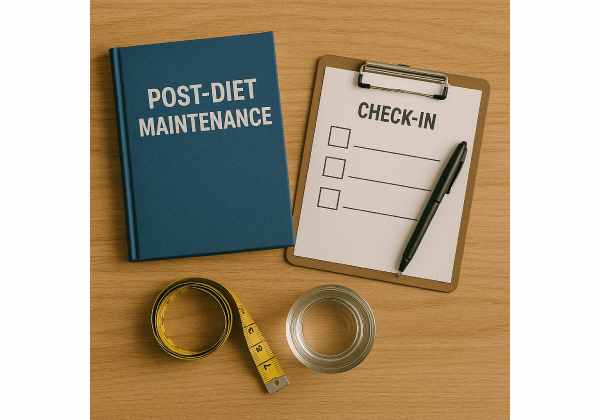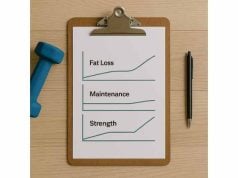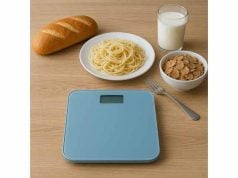
You reached your goal. Now the real work begins: building a life where that goal weight is normal, not temporary. Post-diet maintenance is not a holding pattern. It is a deliberate phase with structure, simple metrics, and clear triggers that keep drift small and reversible. This guide gives you a practical toolkit—how to set maintenance calories you can live with, design “guardrails” that prevent regain, and run low-effort weekly check-ins that catch problems early. We will also cover action triggers for raising or lowering intake and how to handle travel, holidays, and stressful weeks. If you are unsure whether what you are seeing is a true stall or just noise, start with our concise plateau troubleshooting check before you change anything.
Table of Contents
- Post-diet maintenance explained
- Set maintenance calories and macros
- Guardrails that prevent drift
- Weekly check-ins and metrics
- Action triggers to adjust
- Plan for high-risk weeks
- If weight creeps up
- FAQ
Post-diet maintenance explained
Maintenance is a training block, not a pause. The objective is to stabilize body weight, appetite, and performance while you re-expand food choices and social flexibility. Think of it as a bridge from “diet rules” to “daily defaults.” That bridge needs design.
What changes after a cut:
- Energy availability rises. You have more calories to allocate to training quality, recovery, and social life.
- Hunger signals normalize slowly. Appetite can lag behind intake for a few weeks; you may feel hungrier even at maintenance as hormones rebound.
- NEAT rebounds—if you let it. Non-exercise movement tends to creep back up with more energy. Encourage it with simple anchors (post-meal walks, errand on foot).
- Scale volatility returns. Sodium, glycogen, and heavier meals add normal water swings. Averages, not single readings, tell the truth.
Why many regain:
- They remove every diet structure at once.
- They stop weighing entirely or weigh without a plan to interpret the numbers.
- Weekends and social meals expand faster than weekday structure.
- No clear “if this, then that” triggers to catch drift early.
A better way:
- Keep three to five guardrails that fit your lifestyle (you will pick these in Section 3).
- Run one weekly check-in with pre-decided thresholds (Section 4).
- Use small action triggers when thresholds are hit (Section 5).
- Keep training consistent and recovery-friendly—nothing extreme.
If you want a one-page refresher on safe, sustainable fundamentals you can keep using in maintenance, skim our overview of healthy weight-loss basics to make sure your guardrails rest on a solid base.
Key idea: Maintenance succeeds when you replace diet rigidity with light structure plus automatic decisions that do not rely on willpower.
Set maintenance calories and macros
You do not need a perfect formula. You need a starting estimate and a feedback loop.
Step 1 — Estimate your maintenance range
- Start with your last two weeks of cutting data. Add 300–500 kcal/day if you were losing around 0.5–0.7% body weight per week.
- Or use a calculator estimate, then cross-check with two-week scale and waist averages.
- Expect a brief water/glycogen bump of 0.5–1.5% of body weight when you add carbs and sodium back. Judge maintenance only after two weekly averages.
If you want a quick, pragmatic method with examples, see our step-by-step on find your maintenance calories.
Step 2 — Lock in protein and fiber
- Protein: 1.6–2.2 g/kg/day, spread across 3–5 meals (25–40 g per meal).
- Fiber: 25–40 g/day, with 8–12 g at dinner to protect evenings.
Step 3 — Place carbs and fats for your lifestyle
- Keep 20–50 g carbs near training and dinner if late-night hunger is your weak spot.
- Hold a fat “floor” around 0.6–1.0 g/kg/day from olive oil, nuts, seeds, avocado, dairy.
Step 4 — Decide your default meals
Maintenance thrives on repetition with variety at the edges. Choose:
- One default breakfast and one default lunch on workdays.
- Three rotating dinners that fit your macro envelope.
- A planned night snack (150–250 kcal, protein-forward) for days when appetite runs high.
Step 5 — Create a range, not a single target
Use a maintenance band—for example, ±150–200 kcal around your target—so social meals and training days fit without stress. Aim for average compliance over the week, not daily perfection.
What success looks like: Body weight averages steady within ±0.25–0.5%, waist stable, training solid, and hunger manageable most days.
Bottom line: Pick a realistic maintenance estimate, anchor protein and fiber, and build a small menu you can repeat. Adjust with data, not anxiety.
Guardrails that prevent drift
Guardrails are simple rules that keep your behaviors in a safe lane without micromanaging every bite. Choose the fewest that solve your actual friction points.
Movement guardrails
- 3×10-minute post-meal walks (after breakfast, lunch, dinner).
- A step floor you defend on busy days (for many, 7k–10k).
- Stand for 60–120 seconds every 40–60 minutes during desk blocks.
Meal guardrails
- Protein at each meal (25–40 g).
- Veg volume twice/day (salad or cooked veg at lunch and dinner).
- Night snack pre-planned (e.g., Greek yogurt and berries; cottage cheese and tomato; skyr with cinnamon).
Environment guardrails
- Friction on snacks you tend to overeat: put them out of sight or portion them into single servings.
- Easy access to what you want to eat: washed fruit, cut veg, ready protein.
- Alcohol limits that fit your week (e.g., only with a meal, max two days per week).
Weekend guardrails
- One “anchor breakfast” and one walkable errand on both weekend days.
- Restaurant rule of one: pick either a drink, a dessert, or richer sides—not all three.
Social and travel guardrails
- Hydrate and walk (500 ml water + 10-minute walk) before the first social meal of the day.
- Protein first at buffets and events; then choose either starch or dessert if you want a more generous portion.
If you like a short, time-boxed plan for the transition period, our eight-week roadmap for regain prevention helps you practice guardrails until they are automatic.
How many guardrails?
Three to five. More than that becomes a diet. Pick the ones you actually need; you can always swap later.
Bottom line: Guardrails create automatic wins: more movement, stable appetite, and fewer surprise calories—without counting forever.
Weekly check-ins and metrics
Maintenance failure is rarely a single event. It is drift, and drift is visible if you look the right way. Your check-in should take under 10 minutes once per week.
The four metrics to track
- Scale trend: average of daily morning weights.
- Waist or navel measurement, once weekly.
- Step average for the week.
- Training performance: best set or total volume for key lifts, or perceived effort for cardio.
What you are looking for
- Weight average within ±0.25–0.5% of last week = on track.
- Waist stable (±0.5 cm) = on track.
- Steps consistently above your floor = guardrail working.
- Training steady or improving = recovery good.
Add a simple food visibility check
- For three evenings this week, jot down what you planned to eat after dinner and what you actually ate. This catches quiet calorie creep fast.
Compare like with like
- If you had unusually salty meals, traveled, or had poor sleep, expect water weight. Compare averages, not the noisiest day.
- For people with cycles, compare matched weeks month to month.
If you want a minimal daily routine that makes weigh-ins meaningful, use our one-page guide to consistent weigh-ins so single spikes do not derail your plan.
Make the check-in actionable
- If two metrics slip beyond your thresholds, trigger a small, pre-decided change (Section 5).
- If one metric slips, reinforce the specific guardrail tied to it (e.g., step floor, night snack plan).
Bottom line: A 10-minute weekly check-in catches drift early and tells you exactly which lever to pull.
Action triggers to adjust
Action triggers remove guesswork. You decide in advance what you will do when a metric crosses a line. Changes are small and time-boxed so they are easy to reverse.
Choose your thresholds
- Weight: if the 7-day average rises ≥0.75–1.0% from your maintenance baseline for two weeks.
- Waist: if weekly measurement increases ≥1.5 cm and holds for two readings.
- Steps: if your weekly average falls >1,500/day below your floor for two weeks.
- Training: if you lose a rep or load on two key lifts for two weeks, and sleep is poor.
Pick one lever per trigger
- Food structure first: re-establish default breakfast and lunch; pre-plan a 150–250 kcal night snack.
- Movement anchor: reinstall 3×10-minute post-meal walks and defend your step floor.
- Small calorie nudge: trim 100–150 kcal/day from add-ons you don’t notice (oils, dressings, handfuls) or from weekday desserts.
- Macro timing: move 20–40 g carbs to pre-workout or dinner if evening hunger drives over-eating.
Time-box the test
- Run each change for 14 days, then reassess weekly averages.
- If metrics return to baseline, keep the guardrail and return to maintenance band.
- If not, choose one additional lever; avoid stacking change on change.
For the less obvious case—when tightening does not help and fatigue is mounting—use our clear decision tree on when to raise calories. Sometimes a small bump in intake stabilizes appetite and restores movement so weight settles again.
Bottom line: Pre-decided, modest adjustments keep you out of panic mode and prevent over-correction.
Plan for high-risk weeks
Holidays, travel, launches at work, family events—these weeks are predictable. Plan for them and maintenance becomes sturdier than during the diet.
Travel playbook
- Bookend the day: 500 ml water + 10-minute walk after waking and after your largest meal.
- Protein-first rule at airports and restaurants (sandwich with extra meat, yogurt cup, jerky, salads with added protein).
- Sodium steady: expect water swings; judge weight by averages once you are home.
Holiday strategy
- Pick your non-negotiables (favorite dessert, special dish) and keep portions generous for those while keeping other choices simple.
- Restaurant rule of one: choose drink or dessert or richer sides.
- Walk with people. Make the post-meal loop a tradition.
Stressful work weeks
- Keep your default breakfast and lunch exactly the same.
- Use higher-satiety dinners (protein + veg + potato or rice + 10–15 g extra fat) to calm late hunger.
- Accept maintenance as a win; hold the line and resume normal structure after.
For more ideas specific to holidays and trips, skim our focused primer on holiday and travel maintenance so you can keep momentum without food rules that steal the joy of the event.
Bottom line: Decide your defaults before the week hits: movement bookends, protein first, and one indulgence at a time. You will enjoy more and regain less.
If weight creeps up
Regain happens in small, fixable steps. The earlier you act, the easier it is.
Step 1 — Identify the pattern
- Evening creep: snacks after 8 p.m. grow from 150 to 400 kcal.
- Weekend creep: restaurant meals multiply and steps vanish.
- Sodium/glycogen noise: weight jumps after salty or high-carb days but waist stays stable.
- Movement slump: steps drop and sitting blocks lengthen.
Step 2 — Choose the smallest effective fix
- Night appetite: add 8–12 g fiber and 10–20 g protein to dinner; pre-log a 150–250 kcal snack.
- Weekends: schedule a two-hour movement window (walk + chores) and keep anchor breakfast both days.
- Water noise: keep sodium consistent for seven days; judge again by averages.
- Movement slump: defend the step floor and install three stand breaks per work block.
Step 3 — Time-box and review
- Run the fix for 14 days.
- Compare two weekly averages for weight, waist, steps, and training.
- If you are back within your maintenance band and feel good, continue.
- If not—and especially if fatigue is high—decide between a 100–150 kcal trim or a temporary return to a mild deficit (e.g., 250–300 kcal/day) for 2–4 weeks with the same guardrails.
Step 4 — Re-enter maintenance deliberately
- When weight returns to your preferred range, add back 100–150 kcal (usually to dinner and/or night snack) and keep all guardrails.
- Confirm stability with two steady weekly averages before widening flexibility again.
Mindset check
- Maintenance is not a finish line; it is a skill. Your environment will change—travel, seasons, stress. Skills let you respond without drama.
Bottom line: Treat regain like a smoke alarm. Act when it chirps, not when the fire is large. Small, quick adjustments work best.
FAQ
How many calories above my cut should I eat in maintenance?
Most people add 300–500 kcal/day from their final cutting intake, then judge by two weekly averages. Expect a short-term water/glycogen bump as carbs and sodium rise. Keep protein and fiber steady to stabilize appetite while you test your maintenance band.
Do I need to keep tracking forever?
No. Track until guardrails are automatic. Keep a weekly check-in with weight averages, waist, and steps. If metrics hold steady for several weeks, shift to “light tracking” (default meals, planned night snack, weigh weekly). Return to full tracking if drift appears.
What if my weight jumps after a salty or high-carb day?
That is usually water and glycogen, not fat. Keep sodium consistent and hydrate; judge by 7-day averages. If waist is stable and you feel fine, hold steady and reassess after two normal days rather than cutting calories impulsively.
How do I handle weekends without regaining?
Keep anchor breakfast, one walkable errand, and the restaurant rule of one (drink or dessert or richer sides). Pre-plan your night snack and defend your step floor. Weekends are about structure at the edges, not strict dieting.
When should I raise or lower calories?
Use action triggers: raise 100–150 kcal/day if steps and training slump for two weeks despite good sleep and structure. Lower 100–150 kcal/day if weight and waist rise beyond your thresholds for two weeks. Time-box any change for 14 days, then reassess.
Do I need different macros in maintenance?
Protein remains high (1.6–2.2 g/kg/day). Carbs can rise around training and dinner to support performance and evening satiety. Hold a fat floor (0.6–1.0 g/kg/day). Use a maintenance band (±150–200 kcal) so flexibility fits real life.
References
- Systematic review and meta‐analysis of protein intake to support muscle mass and function in healthy adults 2022 (Systematic Review)
- A systematic review, meta-analysis and meta-regression of the effect of protein supplementation on resistance training-induced gains in muscle mass and strength in healthy adults 2018 (Systematic Review/Meta-analysis)
- Dietary Guidelines for Americans, 2020-2025 and Online Materials 2020 (Guideline)
- A systematic review of the use of dietary self-monitoring in behavioural weight loss interventions: delivery, intensity and effectiveness 2021 (Systematic Review)
- Hydration, Hyperthermia, Glycogen, and Recovery 2023 (Systematic Review)
Disclaimer
This article provides general education about post-diet maintenance. It is not a substitute for medical advice, diagnosis, or treatment. If you have medical conditions, significant symptoms, or medications that affect appetite or energy, consult your clinician or a registered dietitian before making changes.
Share and follow
If these guardrails and check-ins helped, consider sharing this guide with someone starting maintenance. For practical templates and future updates, follow us on the social platform you use most—Facebook, X (formerly Twitter), or another network you prefer.










